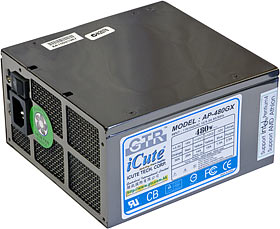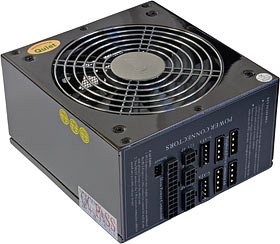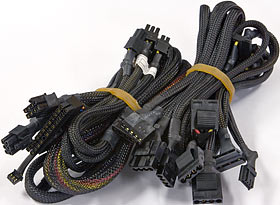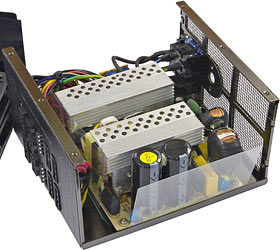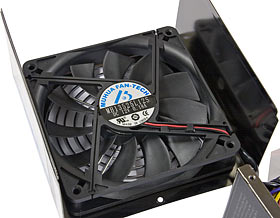
Quick Shot review 30:
GTR AP-480GX PC power supply
Review date: 24th September 2006.
Last modified 03-Dec-2011.
"Modular" computer Power Supply Units (PSU) are a neat idea. Not as neat as the name suggests, though.
A "modular" PSU ought to be some kind of Lego-brick contraption, where you can click in more transistors and capacitors when you need more juice.
That'd be a great idea, except for all of the people electrocuting themselves, and the fact that the modular supply would end up costing more than any five normal ones.
So, instead, "modular" just means a PSU with plugs at both ends of all of its cables. Instead of a box with a cable loom sprouting out of it, modular PSUs are a box with a bunch of sockets on one side. You only plug in the cables you actually need to power whatever hardware you've got in your computer, so you don't have to tuck away a bunch of un-connected cables somewhere in your PC's case.
All sorts of people make modular PSUs these days, including world-famous super-brand Genteelord International Limited, whose products are mercifully just badged "GTR".
This is the GTR AP-480GX (unhelpful product page here, more colourful but not much more useful page for this series of PSUs here).
Here in Australia, Aus PC Market sell the 480GX for $AU137.50, including delivery but, unusually, not including a power cord.
AusPC will cheerfully sell you an IEC lead for $AU12.10. That's not actually a huge rip-off when you bear in mind that it includes delivery, but you can get new and used IEC leads very cheaply on eBay and in your friendly neighbourhood possibly-stolen-goods store. If, of course, you're not the kind of person who has a dozen spares floating around the place all the time anyway.
From this angle, it doesn't look like anything special.
Turn it around, and things get more interesting.
That humungous grille on the top (which'll be the bottom, when the PSU's installed in most PC cases) covers a 14 centimetre (5.5 inch) fan. A lot of PSUs have 12cm fans in them these days, which is good; for a given amount of motor power, a bigger fan gives you more air flow and less noise. This one goes 16.7% better - though it is of course not as remarkable in the fan-size department as some other recent GTR products.
The AP-480GX has a pretty standard set of sockets. From left to right, you've got four "Molex" four pin drive connectors, two SATA cable sockets, and a standard collection of motherboard power connectors - four pin 12V, PCIe video card power, eight pin 12V, and a 24 pin ATX socket.
Why, exactly, the ATX socket is there, I'm not sure. Everybody who installs one of these PSUs in a computer is going to connect the main ATX power cable, so it might as well be hard-wired. Still, I guess this is neat for people who want to pervert the PSU into doing some other task - serving as a second PSU in a giant box with zillions of drives, or powering something other than a PC. You still need to fiddle with the ATX socket to get the PSU to power up, but all that needs to be done is connecting the PS_ON contact (the green wire on the ATX cable; it was pin 14 on the old 20 pin ATX connector and is pin 16 on the 24 pin version) to ground.
Note that there's also a three pin "Sensor" socket on the back of the PSU, so you can hook it up to a motherboard fan header and monitor the speed of the PSU's fan. Yes, you get a sensor cable with the PSU - you can see its plug poking out in the bottom left corner of...
...this picture. The back of the PSU sternly warns you that you "MUST" connect this cable to avoid "voltage drop", which doesn't make a whole lot of sense to me since nothing should be powered by it, either way - it should just be working as a a one wire sensor connection. Still, modern motherboards usually have a spare fan header, so it shouldn't be a big deal to hook it up in most PCs.
As is normal for PC PSUs, some of the (neatly mesh-wrapped) cables have more than one plug on them. So what you end up getting, if you use all of the cables, is one 24 pin ATX plug (which, by the way, you can plug straight into an old 20 pin ATX connector - the extra four pins just hang harmlessly off the end, so unless your motherboard's got components hard up against its power socket, you should be fine), two PCIe power plugs, one eight pin and one four pin 12V motherboard power connectors, seven "Molex" drive power plugs, four SATA power plugs, and one floppy drive plug.
The 480GX has a +3.3V rail rating of 30 amps, +5V of 28 amps, and the usual-these-days twin 12 volt rails (actually, many PSUs these days have three 12V outputs, which is not necessarily a good thing - read more about it in this review), rated at 14 and 15 amps respectively. Do the arithmetic and that gives you 587 watts, but the PSU's actual peak power rating is only 480 watts (hence its name), and it's only rated for 400 watts continuous.
That's more than enough for practically any modern PC, though, and it's on par with the ratings of various other PSUs with numbers between 450 and 500 in their name. If you load most of the world's PC power supplies up to their alleged maximum continuous rating you're dicing with death - well, their death, anyway - so it looks to me as if GTR have just taken this into account already, and had the decency to put a more realistic figure on the specs sticker.
GTR haven't pumped up the power rating by adding the largely irrelevant power ratings for the 5 volt standby and -12V rails, either. Those add up to another 24.5 watts in this PSU, but I can't remember hearing about any PSU ever having not had enough power on either of those rails.
The 480GX doesn't, by the way, have a minus five volt (-5V) rail. But neither do most other PSUs on the shelves these days, as I've discussed before. -5V was removed from the spec as of ATX12V v1.2, which was quite a while ago - ATX12V is now up to v2.2 (PDF). Fortunately, the reason why -5V was removed was that practically nothing needed it any more.
The feature list on the AP-480GX box also says "Electric capacitor with Long Life", which sounds like your usual Chinglish nonsense, but which actually has some connection with reality. The big electrolytic smoothing caps are indeed quite often the first components to fail in a PSU, and lousy electrolytics are far from unknown.
So all of the wires and numbers look better than adequate, particularly for a PSU that costs $AU20 or so less than similarly specified modular PSUs from better known brands.
Time to crack the thing open and see if anything 'orrible emerges.
Not exactly a vision splendid, but good enough.
No giant heat sinks, and not really a whole lot of circuitry either, but there are explanations for both of those things.
The giant fan means that this PSU gets enough airflow to stay cool without giant chunks of aluminium on its power semiconductors. Actually, huge heat sinks could do more harm than good, since they'd block up the inside of the PSU and inhibit air flow - you don't want anything right next to the blades of a standard low-static-pressure computer fan, and the huge fan on this thing has blades that're "right next" to the whole of one face of the casing.
The slightly low component count is explained by the fact that this is a good old fashioned power supply with an input voltage selector switch on the back. It works in 110-120V and 220-240V countries, but only if you set the switch properly.
(The switch on a PSU like this should come from the distributor set to the right position for your country, but it's a good idea to check, especially if you're in a 230V-ish country. If you set it to the 115V position and turn the PSU on, it will see twice the voltage it expects and expire dramatically.)
The hot new thing in PC PSUs is automatic multi-voltage compatibility, which is provided as a side effect of the power factor correction (PFC) hardware that many of them include. Power factor correction is usually promoted with various grand statements about reduced power bills. For the vast majority of users, including virtually every home or small business user in the world, those claims are complete lies, as I explain here (and here, and here, among other places).
In brief, PFC is nice to have, but seldom worth paying for, so it doesn't matter that this PSU doesn't have it. Less to go wrong.
There's a good chance that this PSU is less efficient than the fancy PFC PSUs, too. Power factor correction actually wastes a bit of power, but the more sophisticated design of PFC-equipped PSUs generally means they're at the upper end of the efficiency scale no matter how hard you load them. The 480GX is unlikely to be eligible for 80 Plus certification, though it's sure to be more than 80 per cent efficient at some moderate load or other.
Even if the 480GX is wasting 10% of the power of a 200 watt PC compared with a more efficient PSU, though, that's still only 20 watts. Slightly more than two days per kilowatt-hour of wasted power. Worse, if you're trying to cool your house while the computer's running; better, if you're trying to heat it.
This certainly can add up, if you're paying, say, 20 US cents per kilowatt-hour. But even if the computer's on and drawing an average of 200 watts all day every day, that's still only 35 US bucks a year at 20 cents per kW/h.
In reality, given normal PC duty cycles and the fact that they draw less power when you're not using them (much less, if they're in standby mode), you're going to have a hard time saving twenty US bucks a year from a more efficient PSU. So high efficiency is another thing that's nice to have, but hardly worth big bucks - if the waste heat helps to warm your home, and the rest of your heating is electric as well, high PSU efficiency can actually be worth nothing at all.
If you peer carefully at the above picture, by the way, you'll note that there are a couple of trimmers up the back there. So courageous users can fiddle with the rail voltages to make their overclocked monster run just right. Or, more probably, just make the regulators on their overclocked monster's motherboard warmer.
Oh, and on the right side in the above picture, and on the left side of the first picture, you can see a sizeable unused round hole in the power-input side of the PSU. It's presumably where a cable bundle exits in a different PSU based on the same casing, or perhaps where a speed control knob mounts; it's got a couple of countersunk screw holes and a slot for a slidy switch, for your dangerous hacking pleasure.
The 480GX's huge fan only has a 0.18 amp rating, which'll be somewhat higher than its usual run power. So we're probably talking a bit less than two watts. On the low side for a fan of this size, and guaranteeing decent bearing life and low noise levels. Despite that, this fan's certain to have a free-air flow rating of at least 70 cubic feet per minute, and quite probably more.
In a continuation of this PSU's un-embellished design, the fan has no speed control. No manual control, no thermal sensor. In the great tradition of ordinary boring grey-box PC PSUs, this one's fan just runs at its stock speed all the time.
For the benefit of Google searchers, this fan is made by the entirely uncelebrated Muhua Fan-Tech company, and its model number is MH13525L12S.
Overall
GTR is one OEMed-stuff-from-all-over brand among many, but the gear they choose to call their own is always OK to excellent value for money. At $AU137.50 the AP-480GX only rates an "OK"; it'd score a "Good" if it came with a bleeding power cable. But things get cheaper if you buy a GTR case and power supply from Aus PC Market, because then they give you a $AU29.70 discount (and there are plenty of GTR cases to choose from).
The AP-480GX is basically an old fashioned grey box PSU that's trying to mix it with the cool kids with modular cables and a giant fan. There's nothing wrong with that, though; modular cables make it easier to keep your computer neat and tidy, and the big fan means that you should be able to use this PSU in a simple quiet PC case with one front intake fan, or even no extra fans at all, and not have heat problems unless you get freaky with your CPU and graphics card choices.
The 480GX does have good enough rail ratings to run a pretty serious gaming machine or server, though. If you need even more grunt, AusPC also sell the AP-600GX, essentially the same thing but with a 500 watt continuous rating and a fan lit by blue LEDs, for only $AU27.50 more.
Really old fashioned PSUs with just one low powered 80mm fan do not exhaust enough air to keep most PCs cool all by themselves, but this one has similar fan power and more than three times the fan area, and its lack of a fan speed control means it won't keep spinning up and down and making a single-fan case's heat graph look like a side view of the Andes.
The perfect PSU? No. But not just mutton dressed as lamb, either.
This thing's exactly one power cord away from getting a Recommended rating from me.
Buy one!
The AP-480GX is $AU137.50 delivered from Aus PC Market. Australian shoppers can click here to order one.
If you'd prefer the AP-600GX, with a hundred watt higher continuous rating and a glowy fan, that's $AU165 delivered. Aussie shoppers can click here for that one.
